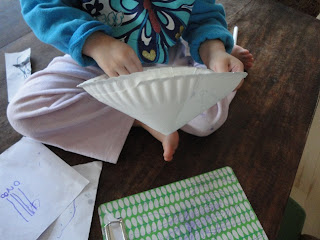We spent an entire morning doing fun experiments that demonstrate 'gravity'. We dropped lots of objects and watched them fall, and jumped off things (while I reiterated that we always land on the ground because gravity pulls us down).
Then I constructed a pendulum for the girls to explore, out of their Tubation set (any pvc piping would work too), and some weights on a string:
The girls swung the pendulums and then waited until they stopped, as I pointed out that when they stop they always point down in the direction of the pull of gravity. They tilted the frame to the side and observed the pendulum's orientation:
Then I altered the frame to have open ends at the top. The girls took turns dropping a unit cube into the center when the frame was level. I asked them to observe the orientation of the pendulums and tell me where they think the cube went. They both pointed to a spot at the top of the frame just below where they had dropped the block. Then they tilted the frame to one side and observed the block fly out:
Then while I was setting up some other experiments, the girls played with dropping objects into water. Originally I was planning on using our plastic weight set to show them that light and heavy weights will sink to the bottom of the water at the same time. However our weights floated, turning this into a lesson on buoyancy instead! We repeated using magnets:
I'm glad we used magnets, because I showed them that we can get them to lift up out of the water, as well - the magnetic force was stronger than gravitational force.
We've been doing a lot of weighing activities with their bucket-scale lately, so I wanted to demonstrate weight in a different way. I created a simple spring-scale out of a clipboard, rubber band, dental floss, and a paper cup. I think the spring-scale makes it easier to associate weight with gravity. We put different numbers of weights in the cup, and L helped me draw a line showing where the top of the cup was. Of course she wanted to do it all by herself (I'm surprised she even let me write the numbers):
L and E took turns adding and removing weights and observing the effects. Then they took a break to take some scientific notes:
The final project of the day was inspired by one of those large funnels at the mall that into which you drop pennies and watch them spin around. I cut through the radius of a paper plate and turned it into a cone. I made a little shelf that a bead could rest on before the girls gave it a push and watched it spin around towards the center (gravity!). We dipped the bead in blue paint and tried to record its path. The girls had lots of fun with this, especially E who repeated the activity over and over:
I don't know who had more fun with our lesson on gravity - me or the girls! I'm not sure at what level the girls are grasping these concepts, but I think that the activities from BFSU will build a foundation that the girls can build on as they learn some of these scientific concepts in a more formal setting when they get older. Furthermore, they are making observations, playing, and having a great time, which is what really counts.















I'm so glad you linked this up to Learning Laboratory at Mama Smiles - the learning activities you did with your kids about gravity are absolutely fantastic!!! I plan to make a pendulum with my little ones asap, and I know they will enjoy your other experiments as well - and so will I!
ReplyDelete